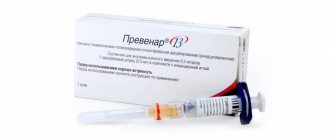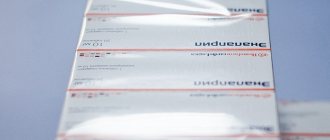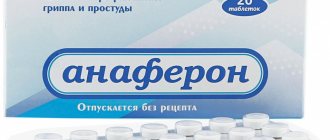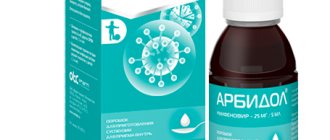"PREVENAR" - vaccination against pneumococcal infection
Pneumococcal polysaccharide vaccine, conjugated, adsorbed, thirteen-valent
Manufacturer: Wyatt Holdings Corporation, USA.
Protects against diseases: neumococcal infection.
Used: in children under 2 years of age. Revaccination at 4, 6 and 12-15 months
Included in the national vaccination calendar.
Why is the Prevenar vaccine needed?
This vaccine is used to prevent most diseases caused by pneumococcus. This bacterium can infect the lungs, blood, brain and other human organs, causing serious complications and causing death. The microorganism is dangerous not only for children, but also for adults.
Most often, a collision with pneumococcus ends in bacterial pneumonia or meningitis. Children and adults with weakened immune systems who have had inflammation of the brain often remain disabled for life. The Prevenar vaccine reduces the risk of infection and complications by 93%. The protective properties of the drug last for 5 years.
Contraindications
Only a doctor can decide whether Prevenar is suitable for a child to be vaccinated
Prevenar vaccination is contraindicated if there is a history of an allergic reaction to any component of the vaccine, as well as in the following cases:
- Hypersensitivity reactions to previous administration of Prevenar drugs (including anaphylactic shock, severe generalized allergic reactions);
- Hypersensitivity to diphtheria toxoid and/or excipients;
- Acute infectious or non-infectious diseases, exacerbation of chronic diseases (vaccination is carried out after recovery or during remission).
- If an acute or exacerbation of a chronic disease occurs, the child receives a deferment until complete recovery or a period of remission. The pediatrician determines the required duration of delay from vaccinations, guided primarily by the risk of complications. In most cases, the delay is about 1 month. In case of meningococcal meningitis and other severe diseases of the nervous system, vaccinations are postponed for a longer period - up to six months from the onset of the disease.
- The main contraindications to vaccination, which provide grounds for medical withdrawal from vaccinations, are strong reactions and post-vaccination complications after the administration of the previous dose of the vaccine. A strong reaction is understood as an increase in body temperature above 40 °C with the occurrence of swelling and redness at the site of vaccine administration over 8 cm in diameter, severe allergic reactions, anaphylactic shock, the development of infectious diseases and damage to individual body systems.
Vaccination scheme
The Prevenar vaccine is available in two forms - seven and thirteen. This number indicates the number of serotypes of bacteria included in the drug. Regardless of the type, only non-living strains are used to prepare the vaccine. Due to this, it is possible to get vaccinated against pneumococcus at the age of 2-3 months.
The vaccination regimen is developed individually for each patient and takes into account both the age-related characteristics of the body and the presence of contraindications. Today, the following vaccine administration regimens exist:
- From 2 to 6 months. Prevenar vaccination is administered four times with revaccination up to 2 years.
- From 7 to 12 months. Two doses of the vaccine are administered with revaccination up to 2 years.
- From one year to 2 years. Two vaccines are administered at an interval not exceeding 2 months.
- From 2 to 5 years. Single administration of the drug.
Instructions for use PREVENAR 13
Vaccine for the prevention of pneumococcal infections.
Mechanism of action
Prevenar 13 contains 13 antigens - capsular polysaccharides of 13 serotypes of Streptococcus pneumonia (4, 6B, 9V, 14, 18C, 19F, 23F, 1, 3, 5, 6A, 7F, 19A), individually conjugated to the carrier protein CRM197. In response to antigenic stimulation, antibodies are produced by B cells in a T-dependent and T-independent manner. The immune response to most antigens is T-dependent in nature and involves the coordinated action of CD4+ T cells and B cells in the process of antigen recognition. CD4+ T cells (T helper cells) transmit signals to B cells directly (through the interaction of proteins on the cell surface) and indirectly (through the release of cytokines). These signals lead to the proliferation and differentiation of B cells and the synthesis of high-affinity antibodies. CD4+ T cell signaling is required for the differentiation of B cells into long-lived plasma cells that continuously synthesize antibodies of multiple isotypes (with an IgG component) and memory B cells that rapidly mobilize and secrete antibodies after repeated exposure to the same antigen.
Bacterial capsular polysaccharides (PS), different in chemical structure, have common immunological properties, being mainly T-independent antigens. In the absence of T-cell help, PS-stimulated B cells synthesize primarily IgM antibodies; Antibody affinity maturation generally does not occur and memory B cells are not produced. In vaccines, PS use is associated with poor or no immunogenicity in children <24 months of age and an inability to induce immunological memory at any age.
Conjugation of PS to a carrier protein overcomes the T-cell-independent nature of PS antigens. T cells with carrier proteins provide the signals necessary for the maturation of the B cell-mediated immune response and the formation of memory B cells. Conversion of Streptococcus pneumoniae PS into a T-cell-dependent antigen (by covalent attachment to the immunogenic carrier protein CRM197) enhances the formation of antibodies and induces immune memory. It has been demonstrated that repeated exposure to pneumococcal polysaccharides in children caused a booster response.
Immunological properties
Administration of the Prevenar 13 vaccine causes the production of antibodies to capsular polysaccharides of Streptococcus pneumoniae, thereby providing specific protection against infections caused by 1, 3, 4, 5, 6A, 6B, 7F, 9V, 14, 18C, 19A, 19F and 23F included in the vaccine serotypes of pneumococcus.
According to WHO recommendations for new conjugate anti-pneumococcal vaccines, the equivalence of the immune response when using the Prevenar 13 and Prevenar vaccines was assessed using a combination of three independent criteria:
- percentage of patients who achieved a concentration of specific IgG antibodies≥0.35 μg/ml;
- geometric mean concentrations of immunoglobulins (IgG GMC) and opsonophagocytic activity of bactericidal antibodies (OPA titer ≥1:8). Introduction Prevenar 13 causes the development of an immune response to all 13 vaccine serotypes, equivalent to the Prevenar vaccine according to the above criteria.
The Prevenar 13 vaccine includes up to 90% of all serotypes that cause invasive pneumococcal infections (IPI), incl. resistant to antibiotic treatment. Observations in the United States since the introduction of the 7-valent Prevenar conjugate vaccine suggest that the most severe cases of invasive pneumonia are associated with the serotypes included in Prevenar 13 (1, 3, 7F and 19A), in particular serotype 3 is directly associated with necrotizing pneumonia.
Immune response using three or two doses in a primary vaccination series
After three doses
With Prevenar 13, during primary vaccination of children under 6 months of age, a significant increase in the level of antibodies to all vaccine serotypes was observed.
After two doses
During primary vaccination with Prevenar 13 as part of mass immunization of children of the same age group, a significant increase in antibody titers to all components of the vaccine was also observed, but the level of IgG≥0.35 μg/ml for serotypes 6B and 23F was determined in a smaller percentage of children. At the same time, the concentration of antibodies after the administration of a booster dose of Prevenar 13 compared with the concentration of antibodies before the introduction of a booster dose increased for all 13 serotypes. The formation of immunological memory is shown for both of the above vaccination regimens. The secondary immune response to a booster dose in children of the second year of life using three or two doses in the primary vaccination series is comparable for all 13 serotypes.
Booster reactions to two-dose and three-dose immunization regimens
Post-booster antibody concentrations were higher for 12 serotypes than the concentrations achieved after the primary immunization series, indicating adequate priming (formation of immunological memory). For serotype 3, antibody concentrations after the primary series of immunization and booster doses were similar. Antibody responses to booster doses after the two-dose and three-dose primary immunization series were comparable across all 13 vaccine serotypes.
In adults aged 50 years and older, serotype-specific polysaccharide-binding IgG antibody levels are not used to predict protection against invasive pneumococcal infections or nonbacteremic pneumonia. It is believed that the reflection of the mechanisms of anti-pneumococcal protection in adults is the functional activity of the antibodies produced - opsonophagocytic activity (OPA) - the ability of serum antibodies to eliminate pneumococci by activating complement-mediated phagocytosis in vitro. Preclinical and clinical data from a study of the immunogenicity of the Prevenar 13 vaccine in adults aged 50 years and older confirm the functional opsonophagocytic activity of post-vaccination serotype-specific OPA antibodies.
Where can you get vaccinated with Prevenar?
You can administer the Prevenar vaccine at our medical center in Mytishchi. We work only with original drugs that have all the necessary certificates. The procedure is carried out by qualified doctors in a specially equipped room. We can also create an individual vaccination schedule for you and your children. Our specialists will perform a preventive examination to identify contraindications, answer any questions you may have, and tell you how to prepare for the procedure. You can sign up for a consultation through the website or by calling the numbers listed in the appropriate section.
Possible side effects
In children 6 weeks to 17 years of age, the most common side effects are irritation, redness or swelling at the injection site, irritability, decreased appetite, decreased or increased sleep, and fever.
Serious but very rare side effects in infants and toddlers include pneumonia, bronchiolitis and gastroenteritis (inflammation of the stomach and small intestine) (0.9% of all vaccine recipients). A temporary pause in breathing after vaccination occurs in some babies born prematurely.
The high safety of vaccination has been confirmed by 230 million years of experience in administering Prevenar over the past 10 years. The vaccine is registered in 88 countries and is included in the national vaccination calendars of 30 countries.
Come get vaccinated at VIRILIS. A full range of vaccines for children and adults, family vaccinations - at a special price!
MANUFACTURER
- Wyeth Pharmaceuticals Division of Wyeth Holdings Corporation, USA 401 North Middletown Road, Purple River, New York 10965, SSD;
- Baxter Pharmaceutical Solutions LLC, USA 927 South Curry Nike, Bloomington, IN 47403, USA;
- Pfizer Ireland Pharmaceuticals, Ireland Grange Castle Business Park, Clondalkin, Dublin 22. Ireland;
- LLC "NPO Petrovax Pharm", Russian Federation 142143, Moscow region, Podolsky district, village. Pokrov, st. Sosnovaya, 1;
- Packaged by: Wyeth Pharmaceuticals, United Kingdom New Lane, Havant, Hampshire, P09 2NG, United Kingdom or NPO Petrovax Pharm LLC, Russian Federation 142143, Moscow region, Podolsk district, p. Pokrov, st. Sosnovaya, 1
special instructions
The Prevenar vaccine is not used in adult patients.
It is recommended to delay administration if there is an acute illness accompanied by both moderate and severe hyperthermia. To avoid the development of any reactions, after vaccination the baby must be under the supervision of a specialist for 30 minutes. The rest of the time, while at home, parents should monitor the general condition of the child.
It has been established that the benefits of vaccination for this group of patients are the highest, so it should not be abandoned or postponed. However, it must be remembered that Prevenar does not protect against Streptococcus pneumoniae serotypes that are not present in its composition and against microorganisms that cause other invasive diseases.
Vaccination with Prevenar is not prescribed for children suffering from thrombocytopenia and other disorders associated with blood clotting. Such patients are not prescribed intramuscular injections. The exception is when the potential benefit of vaccination significantly outweighs the risk involved in administering the vaccine.
The presence of immunoreactivity disorders due to immunosuppressive treatment for HIV infection and so on may reduce the formation of antibodies in response to vaccination. In general, the decision to vaccinate children belonging to various high-risk groups is recommended to be made individually.
Prevenar is produced in a ready-to-use syringe, so its contents are not recommended to be placed in another container or mixed with any medications.
Analogs
Level 4 ATX code matches:
Pneumo 23
The main analogues of this drug are: Vaccine for the prevention of hepatitis B and Pneumo 23.
Prevenar 13 or Pneumo 23 - which is better?
Many parents express a desire to vaccinate their child against pneumococcal infections , but do not know which vaccine to choose: Prevenar 13 or Pneumo 23 ? Experts recommend choosing Prevenar 13, although it has a smaller number of serotypes, but since this drug better builds immunity, its effectiveness is higher.
Pharmacodynamics and pharmacokinetics
Vaccines for the prevention of pneumococcal infections contain active substances, which are pneumococcal polysaccharides, obtained from the gram-positive bacteria Streptococcus pneumoniae, conjugated to the diphtheria carrier protein CRM197, and adsorbed on aluminum phosphate .
When the drug is administered, the production of antibodies to the capsular polysaccharides of Streptococcus pneumoniae of several serotypes begins, which allows for specific protection of the human body from the infections that they cause.
CLAIMS
Consumer complaints should be sent to:
- Representative office of Pfizer H Corporation. Si. Pi. Corporation, 123317 Moscow, Presnenskaya embankment, 10, Business Center "Tower on Naberezhnaya" (Block C) Phone: +7 (495) 287-5000, fax: +7 (495) 287-5300;
- LLC "NPO Petrovax Pharm", Russian Federation 142143, Moscow region, Podolsky district, village. Pokrov, st. Sosnovaya, 1 Tel./fax: +7 (495) 926-2107, e-mail;
- Federal Service for Surveillance in Healthcare (Roszdravnadzor): 109074, Moscow, Slavyanskaya Square, 4, building 1 Tel.: +7 (495) 698-4538; +7 (499) 578-0230.
RELEASE FORM
Suspension for intramuscular administration 0.5 ml/dose.
Equipment
- 0.5 ml in a 1 ml syringe made of transparent, colorless glass (type 1). 1 syringe and 1 sterile needle in a plastic package sealed with plastic film. 1 plastic package together with instructions for use in a cardboard box;
- 5 syringes in a plastic package, sealed with plastic film;
- 2 plastic packages and 10 sterile needles along with instructions for use in a cardboard box;
- When packaged at NPO Petrovax Pharm LLC: 0.5 ml in a 1 ml syringe made of transparent colorless glass (type 1). 1 syringe and 1 sterile needle in a plastic package sealed with plastic film. 1 plastic package together with instructions for use in a cardboard box.
Why is the Prevenar vaccine included in the vaccination schedule?
Prevenar is a vaccine designed to prevent pneumococcal infections.
Pneumococcus is “responsible” for 30% of all pneumonia, and such pneumonia is severe and with complications (such as pleurisy, lung abscess, pericarditis, arthritis, sepsis).
Children under 5 years of age are at risk for pneumococcal pneumonia. Pneumococcus causes from 30% to 60% (according to various sources) of childhood otitis media.
Pneumococcal infection is a common cause of meningitis and sepsis in children and adolescents.
METHOD OF APPLICATION AND DOSAGE
Do not administer Prevenar 13 intravascularly or intramuscularly into the gluteal region!
The vaccine is administered in a single dose of 0.5 ml intramuscularly. For children of the first years of life, vaccinations are administered into the upper outer surface of the middle third of the thigh, for persons over 2 years of age - into the deltoid muscle of the shoulder.
Before use, the syringe with the Prevenar 13 vaccine must be shaken well until a homogeneous suspension is obtained. Do not use if inspection of the contents of the syringe reveals foreign particles, or the contents look different than those described in the “Description” section of these instructions.
If vaccination with Prevenar 13 is started, it is recommended to complete it with the Prevenar 13 vaccine. If the interval between injections of any of the above vaccination courses is forced to increase, the administration of additional doses of Prevenar 13 is not required.
Possible reactions due to vaccination
In most cases, the Prevenar 13 vaccine is well tolerated, including in young patients and those at risk. You can buy Prevenar in Moscow, followed by an injection for the purpose of immunization. However, in some situations, negative reactions such as pain at the injection site, low-grade fever, malaise, and weakness are observed. In most cases, all these symptoms disappear on their own within a few days without the use of special medications. In extremely rare cases, anaphylactic shock is possible, so at the time of immunization a doctor must be present who can provide first aid with all the necessary equipment.
COMPOUND
Composition per dose (0.5 ml)
Active substances:
Pneumococcal conjugates (polysaccharide - CRM197):
- Polysaccharide serotype 1 - 2.2 μg;
- Polysaccharide serotype 3 - 2.2 μg;
- Polysaccharide serotype 4 - 2.2 μg;
- Polysaccharide serotype 5 - 2.2 μg;
- Polysaccharide serotype 6A - 2.2 μg;
- Polysaccharide serotype 6B - 4.4 μg;
- Polysaccharide serotype 7F - 2.2 μg;
- Polysaccharide serotype 9U - 2.2 μg;
- Polysaccharide serotype 14 - 2.2 μg;
- Oligosaccharide serotype 18C - 2.2 μg;
- Polysaccharide serotype 19A - 2.2 μg;
- Polysaccharide serotype 19F - 2.2 μg;
- Polysaccharide serotype 23F - 2.2 μg;
- Carrier protein CRM197 - 32 μg.
Excipients:
- Aluminum phosphate - O, mg (in terms of aluminum 0.125 mg);
- Sodium chloride - 4.25 mg;
- Succinic acid - 0.295 mg;
- Polysorbate 80 - 0.1 mg;
- Water for injection - up to 0.5 ml.
Immunological effectiveness
The use of the vaccine for children from 2 months allows the formation of a protective immune response after primary vaccination and revaccination. The introduction of 3 doses of primary vaccination, and then subsequent revaccination contributes to a significant increase in antibody levels. The drug induces the production of functional antibodies to the serotypes that make up the vaccine.
In young patients 2-5 years of age, antibodies to vaccine serotypes are formed after a single use. In this case, the immune response almost corresponds to the results of examination of children who received a series of primary immunizations .
In addition, the Prevenar 13 vaccine is administered to prevent infectious diseases, pneumonia and acute otitis media.
The comparative identity of these vaccines in terms of safety and immunogenicity profile makes it possible to switch from Prevenar to Prevenar 13 at almost any stage of vaccination. Moreover, 6 additional serotypes will only enhance protection against IPD.





